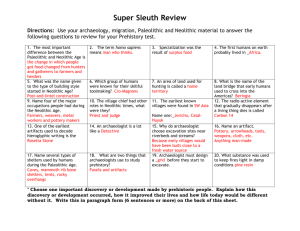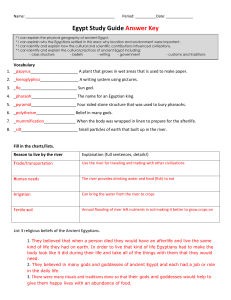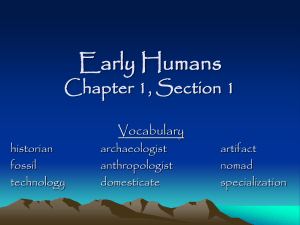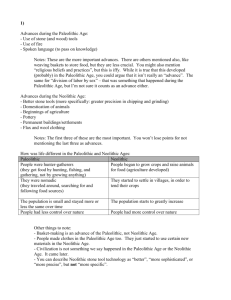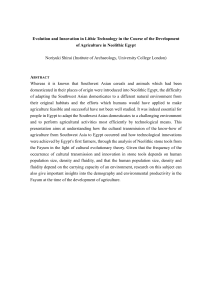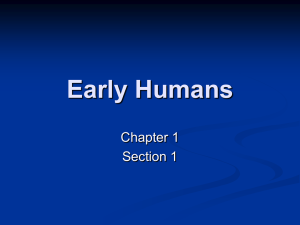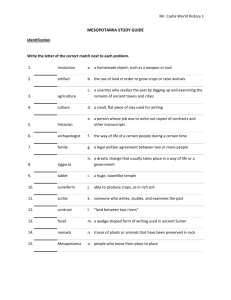Vocabulary
advertisement
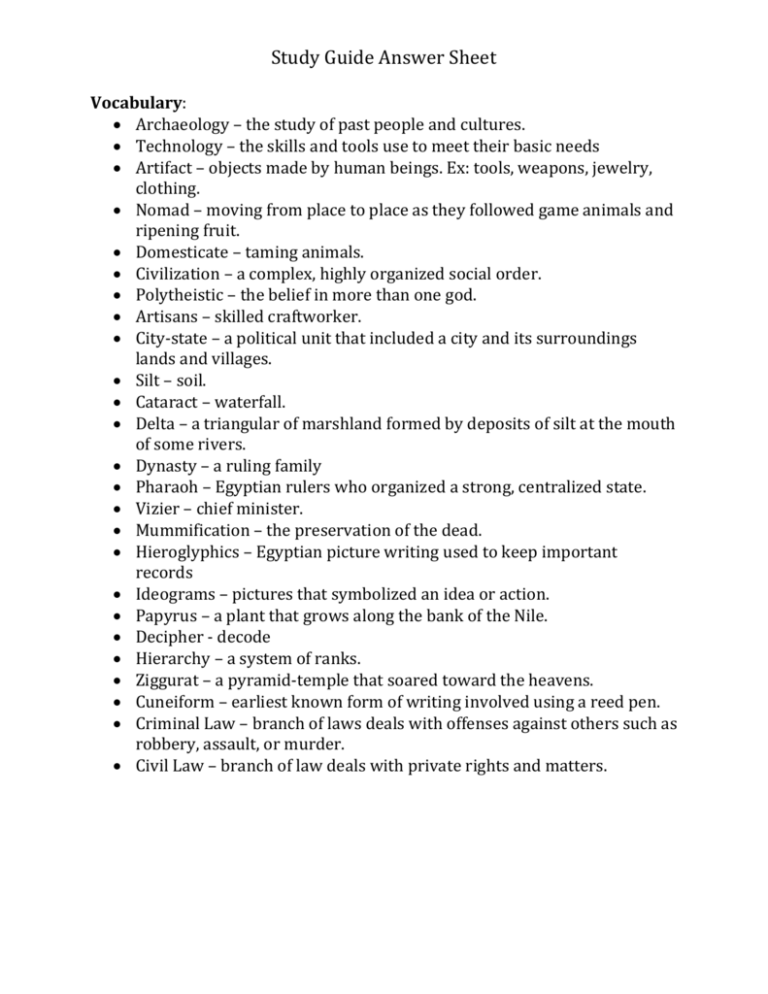
Study Guide Answer Sheet Vocabulary: Archaeology – the study of past people and cultures. Technology – the skills and tools use to meet their basic needs Artifact – objects made by human beings. Ex: tools, weapons, jewelry, clothing. Nomad – moving from place to place as they followed game animals and ripening fruit. Domesticate – taming animals. Civilization – a complex, highly organized social order. Polytheistic – the belief in more than one god. Artisans – skilled craftworker. City-state – a political unit that included a city and its surroundings lands and villages. Silt – soil. Cataract – waterfall. Delta – a triangular of marshland formed by deposits of silt at the mouth of some rivers. Dynasty – a ruling family Pharaoh – Egyptian rulers who organized a strong, centralized state. Vizier – chief minister. Mummification – the preservation of the dead. Hieroglyphics – Egyptian picture writing used to keep important records Ideograms – pictures that symbolized an idea or action. Papyrus – a plant that grows along the bank of the Nile. Decipher - decode Hierarchy – a system of ranks. Ziggurat – a pyramid-temple that soared toward the heavens. Cuneiform – earliest known form of writing involved using a reed pen. Criminal Law – branch of laws deals with offenses against others such as robbery, assault, or murder. Civil Law – branch of law deals with private rights and matters. Nine Themes of History: Define the 9 themes of World History: (you will the need the definition as well as to be able to interpret scenarios using the themes) Political and Social Systems - Kings and queens, presidents and dictators, elected congress – each society has a way to govern itself. A government tries to keep order within a society and protect it from outside threats. Societies have important institutions including the most basic – family. Social classes rank people based on wealth, ancestry, occupation or education. Economics and Technology - are usually linked in that as technology has improved over the years the economy has changed. Certain aspects of the economy have caused trading networks, wars, and contributed to the rise or decline of nations. Religion and Value Systems - How was the world created? How can we tell right from wrong? What happens to us after death? Example of value system: respect for parents, equality, and justice. Continuity and Change - change is something that is taking place among all societies. For example: the shifting role of women. Continuity is the enduring of traditions. For example: the political system today is affected by standards set 3000 years ago. Geography - influences the work people do, the clothes they wear, the food they eat, and how they travel. Example: Nile River in Egypt was used to transport goods and people. Global Interaction - There are many ways people interact: trade, migration, foreign policy, war, and transportation. Impact of the Individual - People have such an impact on events that we remember them long after they die. Example: Martin Luther King Jr. fought for equality between white and black Americans during the 1960s. Diversity - the term generally means “different.” Throughout the world, there are many types of diversity: language, government, social class, culture. Art and Literature - people create art and literature to reflect their lives and values. Examples: Temples, Buildings, Cave paintings, and portraits. 8 Features of Civilization: Be sure to provide some examples for each feature. Cities - emerged after farmer began cultivating lands along river valleys and producing a surplus of food Public Works - People working for the benefit of the people, irrigation systems, roads, bridges, and defense walls. Job Specialization - Urban people developed so many new crafts that a single person could no longer master all the skills leading to artisans Art and Architecture - expressed beliefs and values of people who created them Strong Central Government - forms of government arose to oversee irrigation, and maintain large food supplies. Priests initially had the greatest power, eventually taken by warrior kings. Complex Religion - most people were polytheistic – belief in more than one god. Writing - early writings made of pictographs or simple drawings, as writing grew more complex only specialized people (scribes) could write Social Classes - people were ranked according to their jobs, priests and nobles usually occupied the top level, a small class of wealthy merchants, artisans, bottom was peasant farmers (vast majority of people) Paleolithic and Neolithic Explain the difference between the Paleolithic and Neolithic eras? – the Paleolithic was known as the Old Stone Age. People were nomadic tribesmen migrating from one place to another. Paleolithic people hunted and gathered foods for their tribes. Neolithic era is known as the New Stone Age and Neolithic Agricultural Revolution. The Neolithic period introduced the method of farming and people settled in permanent villages instead of migration. Both gender roles provided roles in prehistoric society. Were both gender roles similar during both Paleolithic and Neolithic? Why or Why not? – No. During the Paleolithic period, both men and women hunted and/or gathered foods for their tribe(s). In the Neolithic period, Men dominated all roles in society relating to political, economic, and social matters. Women were considered as housewives: cleaning, cooking and taking care of children. How did the new technologies improved society during the Neolithic era? – Farming was the biggest technology during the time period. Because of farming, pre-historic people could: IN ORDER TO FARM PRODUCTIVELY PEOPLE HAD TO INVENT NEW TECHNOLOGIES o HAD TO FIGURE OUT WAYS TO PROTECT CROPS AND MEASURE OUT ENOUGH SEED FOR THE NEXT YEAR’S HARVEST o HAD TO BE ABLE TO MEASURE TIME ACCURATELY TO DETERMNE THE APPROPRIATE TIME TO PLANT – GRADUALLY THEY CREATED THE FIRST CALENDERS o LEARNED HOW TO USE ANIMALS TO PLOW THE FIELDS o ABOUT 5,000 YEARS AGO THE ADVANCEMENTS MADE BY EARLING FARMING COMMUNITIES LED TO THE DEVELOPMENT OR EMERGENCE OF CIVILIZATIONS Ice Man Approximately how many years ago did the Ice Man lived? The Ice Man lived about 5,000 years ago Based on the artifacts discovered near the Ice Man, how would you describe the day-to-day life in pre-historic society? Life in pre-historic society is described as a society when people hunted or gathered for food in order to survive. People lived in cold regions, due to the cape fragment. Sometimes people migrated from one place to another to search for a better dwelling or more food. Due to the copper axe, people in pre-historic society developed better technology for their society. Develop three possible theories on the Ice Man’s occupation in prehistoric society? Possible Occupations: 1. Hunter/Gatherer 2. Migrate herder 3. Shaman 4. Chief Leader 5. Warrior 6. Explorer Ancient Egypt and Sumer Based on the chart on Ancient Egypt and Sumer, choose three topics and compare and contrast the two civilizations. Examples for each: Government: Religion: Economy Egypt Pharaoh Supernatural Gods Foreign Conquest Geography Nile River Social Classes Accomplishments Ruling Family (Upper) Pyramids Sumer City-States Human-like Gods Trade brought riches to cities Tigris and Euphrates Slaves (Lower) Cuneiform Describe Ancient Egyptian “belief of the afterlife.” The Egyptians were polytheistic, belief in many gods and goddesses. Such gods and goddesses include: Amon-Re, Osiris, Isis, Horus. The Egyptians believed in an afterlife. The pharaoh, besides being a political leader, was a descendant to the gods. The Egyptians believed they have to pass a test in order to get into the afterlife. Osiris, the god of the underworld, would determine the fate by measuring a heart and feather of truth. Egyptians would preserve the bodies to protect from evil spirits, mummification. The mummies would be placed into tombs with their personal belongings to bring into the afterlife. Explain the significance of Lower and Upper Egypt. Lower Egypt is located in the North, where the Nile empties out towards the Mediterranean Sea. It is below sea level, where the soil becomes fertile and farmers can be able to grow crops. Upper Egypt is located South of Egypt that stretches towards the first cataracts. The region is above sea level, which the land is all mountains and desert and less permanent villages; hard to grow crops. Know the leaders, accomplishments and decline of the Old, Middle, and New Kingdom. Old Middle New Leadership: Pharaohs Vizier Accomplishments Pyramids Pharaohs Ramses II Hatshepsut Irrigation systems Military tech. Decline Cost of Pyramids Power struggle Crop failure Hyksos were kicked out of Egypt, led towards New Kingdom First peace treaty First female pharaoh Invaders Power struggle How did the Sumerians try to survive the dangerous floods from the Tigris and Euphrates rivers? Support your answer. Both the Tigris and Euphrates rivers would flow instantly wiping out crops and destroying mud-brick villages. In order to survive, Sumerian villages had to work together, leadership was included to prevent floods from destroying villages, and people constructed dikes to prevent floods from destroying their villages and crops. How did Hammurabi keep society within order? Based on the Code of Hammurabi: provide an example for civil and criminal law. Due to the harsh and cruel laws of Hammurabi’s code, the laws ensures that the government enforces the laws and people must follow in order to maintain order, otherwise a society without laws will go chaotic. Example of Civil Law: if a person knocks out a tooth of his equal, he shall knock his own tooth. Criminal law: If somebody kidnaps a child, he shall be put to death.



